Stater Bros Bundle
Who Really Calls the Shots at Stater Bros.?
Ever wondered about the forces steering a regional supermarket giant like Stater Bros.? The Stater Bros SWOT Analysis can reveal a lot. From its humble beginnings to its current market presence, the story of Stater Bros. is a fascinating case study in corporate evolution. Understanding the company's ownership structure is key to unlocking its strategic decisions and future prospects.
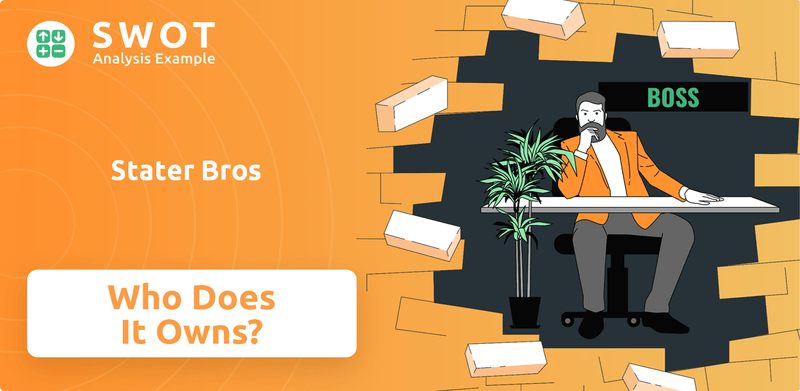
The journey of Stater Bros. from a family-run grocery store to a major player in the Southern California market is a testament to its adaptability. Knowing who owns Stater Bros. is crucial for understanding its operational accountability and its position in the competitive landscape. This exploration into Stater Bros ownership will shed light on the company's current owner, its leadership team, and the factors influencing its trajectory, offering valuable insights for investors and industry observers alike. Uncover the Stater Bros history and background and learn about the Stater Bros CEO.
Who Founded Stater Bros?
The story of Stater Bros began in 1936 with twin brothers Cleo and Leo Stater. Their shared vision led to the founding of what would become a prominent supermarket chain in Southern California. The initial ownership of Stater Bros. was firmly rooted in the Stater family.
The brothers' backgrounds in the grocery business provided the foundation for their venture. While the exact initial equity split is not publicly available, it's understood that Cleo and Leo Stater were the primary owners. Their hands-on approach and commitment were crucial in the company's early years.
Early on, the ownership structure of Stater Bros. remained closely held within the Stater family. Information regarding early investors or significant outside shareholders during the initial phase of the company is not widely publicized. The company's growth was primarily driven by reinvestment and the dedication of the founders.
The early ownership of Stater Bros. was primarily held by the founding brothers, Cleo and Leo Stater. The company's initial growth was fueled by reinvesting profits. There's no widely available information about external investors or significant early shareholders.
- The founders' direct involvement was key to the company's early success.
- Details about vesting schedules or founder exits from the early years are not publicly documented.
- Any early ownership disputes or buyouts among the founding members are not widely documented.
- The founders' focus on quality groceries and customer service was closely linked to their direct ownership and operational control.
Stater Bros SWOT Analysis
- Complete SWOT Breakdown
- Fully Customizable
- Editable in Excel & Word
- Professional Formatting
- Investor-Ready Format
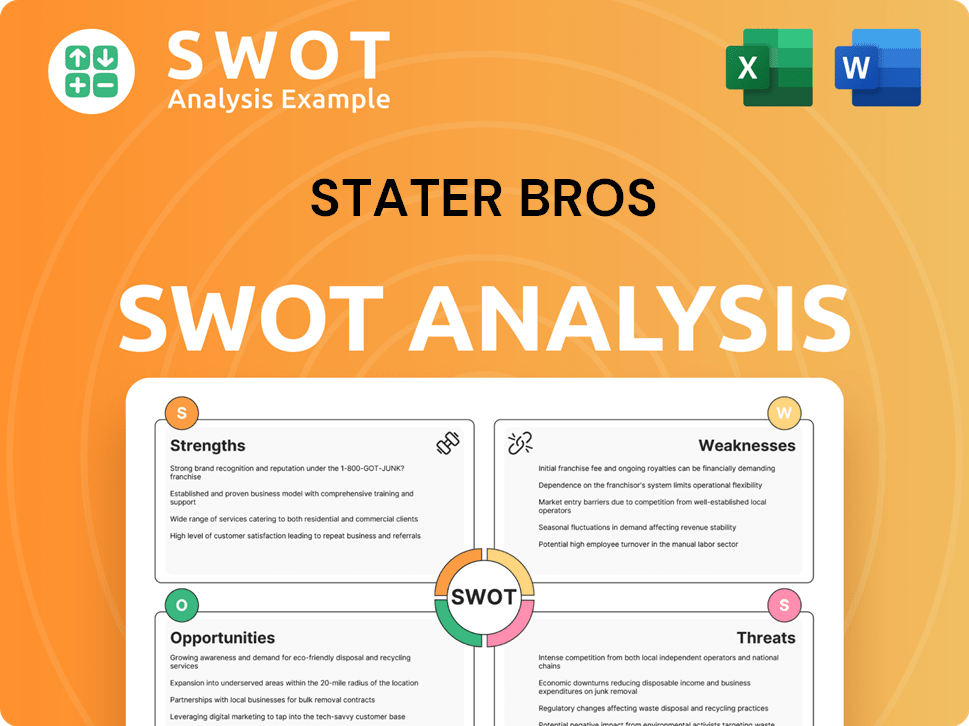
How Has Stater Bros’s Ownership Changed Over Time?
The evolution of Stater Bros ownership reflects a journey from family roots to corporate acquisitions and, finally, to private ownership. Initially, the company was under the direct control of its founders. However, this changed in 1964 when Petrolane Inc., a diversified company, acquired the supermarket chain. This marked a significant transition away from family management.
The ownership structure shifted again in 1983 when La Cadena Investments, spearheaded by Donald Haggen and other executives, purchased Stater Bros. from Petrolane. This acquisition brought the company back under leadership with a more focused approach, although not directly from the founding family. In 1986, the current ownership group, led by Chairman and CEO Pete Van Helden, acquired Stater Bros., solidifying its status as a privately held company.
| Year | Event | Impact |
|---|---|---|
| 1964 | Acquisition by Petrolane Inc. | Transition from family ownership to corporate ownership. |
| 1983 | Acquisition by La Cadena Investments | Shift to a more focused leadership structure. |
| 1986 | Acquisition by current ownership group | Establishment of private ownership under current leadership. |
As of 2024-2025, Stater Bros. remains privately owned. This structure means that detailed financial and ownership information is not publicly available, unlike publicly traded companies. The private ownership allows for long-term strategic planning, which influences its conservative growth strategies and community-focused approach. The primary stakeholders include the executive leadership team and various private investment entities. The company has approximately 170 stores and around 18,000 employees as of recent reports.
Stater Bros. ownership has evolved through several key acquisitions, moving from family control to corporate entities and finally to private hands. The current ownership structure, led by the CEO, allows for long-term strategic planning.
- Petrolane Inc. acquired Stater Bros. in 1964.
- La Cadena Investments acquired Stater Bros. in 1983.
- The current ownership group acquired Stater Bros. in 1986.
- Stater Bros. is privately held as of 2024-2025.
Stater Bros PESTLE Analysis
- Covers All 6 PESTLE Categories
- No Research Needed – Save Hours of Work
- Built by Experts, Trusted by Consultants
- Instant Download, Ready to Use
- 100% Editable, Fully Customizable
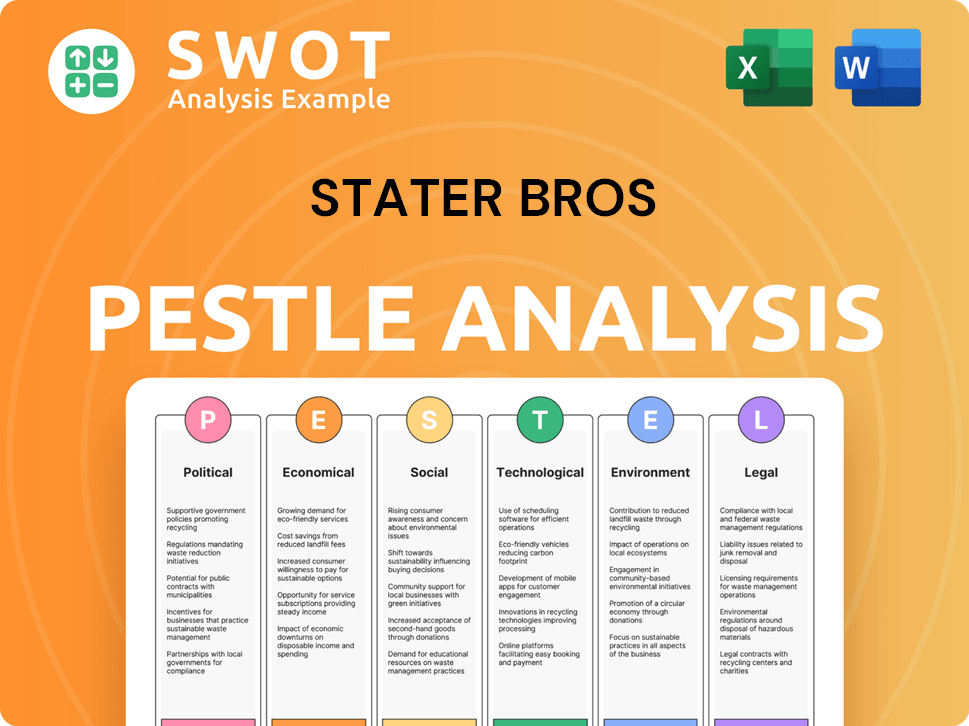
Who Sits on Stater Bros’s Board?
As a privately held company, the specifics of the Stater Bros. Markets' Board of Directors are not publicly available in the same detail as those of a publicly traded company. However, it's known that the board includes key executives and representatives of major stakeholders. Pete Van Helden currently serves as the Chairman and CEO of Stater Bros., indicating his significant influence within the company. The exact composition, including the names and affiliations of all board members, is not readily accessible to the public due to the company's private status. Understanding the full board structure is crucial for anyone researching Stater Bros history and background.
Given that Stater Bros. is a private entity, its voting power structure differs significantly from that of a public company. There's no public information on specific voting rights, such as one-share-one-vote or dual-class shares. The control and voting power are primarily concentrated among the principal owners and the executive leadership team. The decisions within the company are likely shaped by the core ownership group and the board, aligning with the long-term strategic vision of a privately held entity. The current owner of Stater Bros and the Stater Bros parent company are not publicly disclosed.
| Board Member | Title | Affiliation |
|---|---|---|
| Pete Van Helden | Chairman and CEO | Stater Bros. Markets |
| (Details Not Publicly Available) | Board Members | Key Executives, Stakeholder Representatives |
| (Details Not Publicly Available) | Board Members | Key Executives, Stakeholder Representatives |
The Stater Bros. supermarket chain, with its headquarters located in San Bernardino, California, has maintained its private status, which influences its operational and governance structures. This impacts how information about its ownership and leadership is disseminated. The Stater Bros CEO plays a vital role in shaping the company's direction.
Stater Bros. is privately held, meaning its ownership structure is not subject to the same public disclosure requirements as publicly traded companies.
- The Board of Directors includes key executives and representatives of major stakeholders.
- Pete Van Helden serves as Chairman and CEO, indicating significant leadership.
- Voting power is concentrated among principal owners and the executive team.
- Public information on specific voting rights is not available.
Stater Bros Business Model Canvas
- Complete 9-Block Business Model Canvas
- Effortlessly Communicate Your Business Strategy
- Investor-Ready BMC Format
- 100% Editable and Customizable
- Clear and Structured Layout
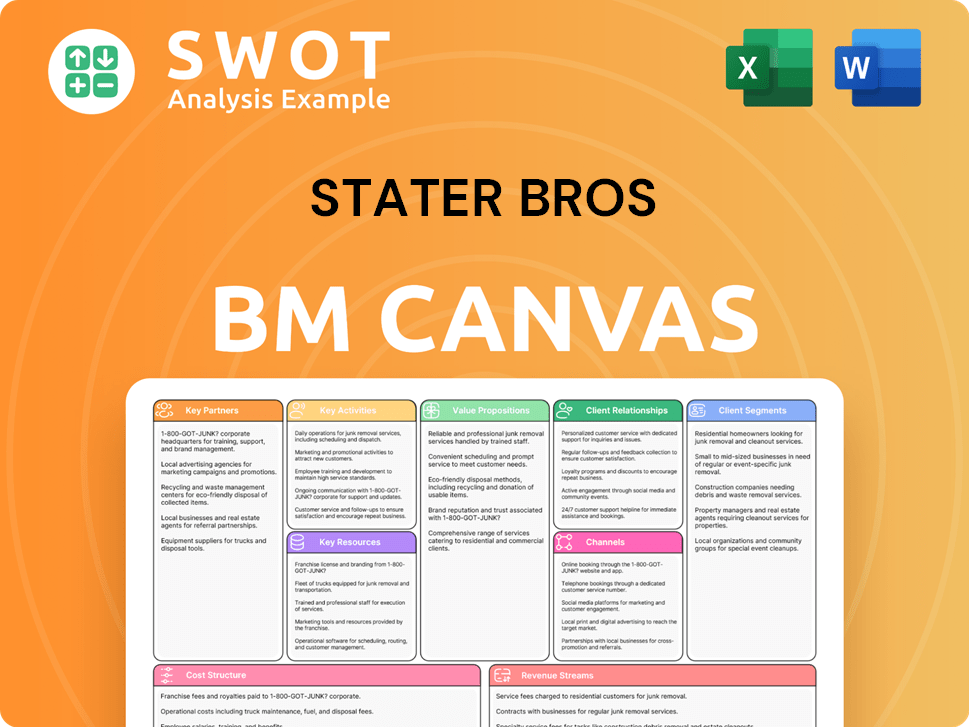
What Recent Changes Have Shaped Stater Bros’s Ownership Landscape?
Over the past few years, the ownership structure of Stater Bros has remained consistent, reflecting its private status. There haven't been any major public announcements about significant changes in ownership, such as share buybacks or mergers. The company continues to focus on its core operations in Southern California, emphasizing community engagement and customer service. Leadership changes, while present, haven't altered the fundamental ownership structure. For instance, promotions within the executive team indicate internal growth and succession planning rather than external ownership changes.
Industry trends in the grocery sector include increased consolidation and a focus on operational efficiency. While Stater Bros hasn't engaged in high-profile mergers and acquisitions, it continues to invest in its existing store base and supply chain. The broader trends of increased institutional ownership or founder dilution, common in public markets, don't directly apply to Stater Bros due to its private status. As of mid-2025, Stater Bros appears committed to its established private ownership model, allowing it to navigate industry changes with a more insulated and long-term perspective. For more insights into the company's approach, consider reading about the Marketing Strategy of Stater Bros.
| Aspect | Details | Status (as of mid-2025) |
|---|---|---|
| Ownership Structure | Private | Maintained |
| M&A Activity | Significant mergers or acquisitions | None |
| Leadership Changes | Internal promotions and appointments | Ongoing |
The Stater Bros leadership team is focused on operational efficiency and technological integration to stay competitive within the grocery sector. This approach is consistent with the company's long-term strategy. The company's focus on its core business and the absence of significant ownership changes suggest a commitment to its current operational model.
Stater Bros ownership has remained private, with no major shifts in the last few years. This structure allows the company to focus on long-term strategies. The current owner of Stater Bros continues to emphasize community engagement.
The Stater Bros CEO and the leadership team have been focused on internal growth. Recent leadership promotions signal a focus on succession planning. These changes have not affected the company's private ownership.
Stater Bros maintains a significant market share in Southern California. The company's focus is on serving its local customer base. Its private status allows it to focus on its core business.
Stater Bros has numerous store locations across Southern California. The company continues to invest in its existing store base. Its commitment to its established private ownership model is evident.
Stater Bros Porter's Five Forces Analysis
- Covers All 5 Competitive Forces in Detail
- Structured for Consultants, Students, and Founders
- 100% Editable in Microsoft Word & Excel
- Instant Digital Download – Use Immediately
- Compatible with Mac & PC – Fully Unlocked
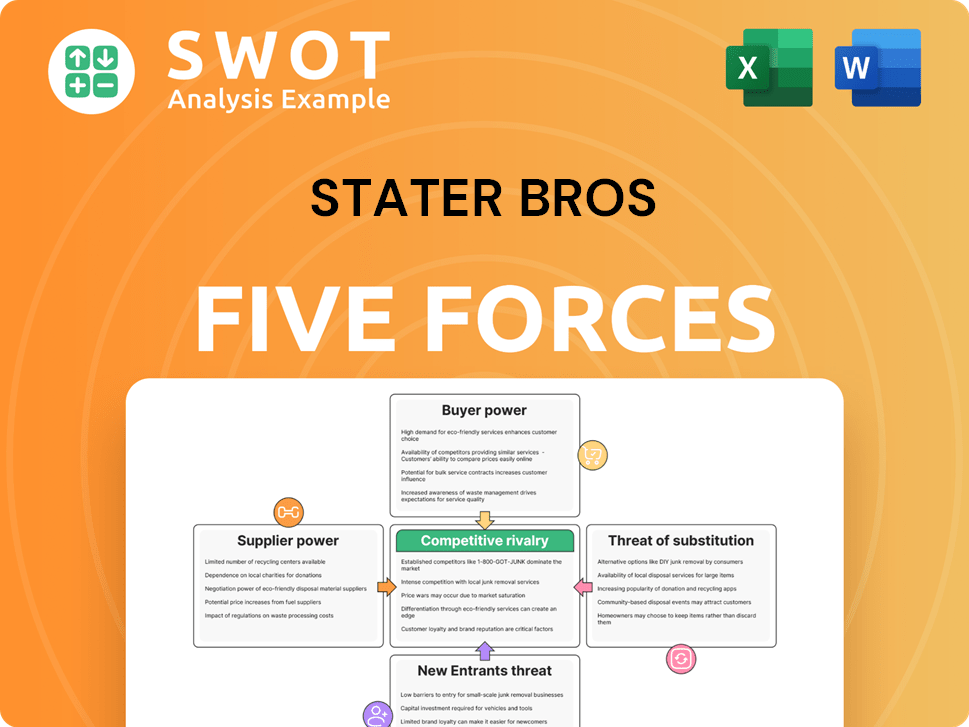
Related Blogs
- What are Mission Vision & Core Values of Stater Bros Company?
- What is Competitive Landscape of Stater Bros Company?
- What is Growth Strategy and Future Prospects of Stater Bros Company?
- How Does Stater Bros Company Work?
- What is Sales and Marketing Strategy of Stater Bros Company?
- What is Brief History of Stater Bros Company?
- What is Customer Demographics and Target Market of Stater Bros Company?
Disclaimer
All information, articles, and product details provided on this website are for general informational and educational purposes only. We do not claim any ownership over, nor do we intend to infringe upon, any trademarks, copyrights, logos, brand names, or other intellectual property mentioned or depicted on this site. Such intellectual property remains the property of its respective owners, and any references here are made solely for identification or informational purposes, without implying any affiliation, endorsement, or partnership.
We make no representations or warranties, express or implied, regarding the accuracy, completeness, or suitability of any content or products presented. Nothing on this website should be construed as legal, tax, investment, financial, medical, or other professional advice. In addition, no part of this site—including articles or product references—constitutes a solicitation, recommendation, endorsement, advertisement, or offer to buy or sell any securities, franchises, or other financial instruments, particularly in jurisdictions where such activity would be unlawful.
All content is of a general nature and may not address the specific circumstances of any individual or entity. It is not a substitute for professional advice or services. Any actions you take based on the information provided here are strictly at your own risk. You accept full responsibility for any decisions or outcomes arising from your use of this website and agree to release us from any liability in connection with your use of, or reliance upon, the content or products found herein.